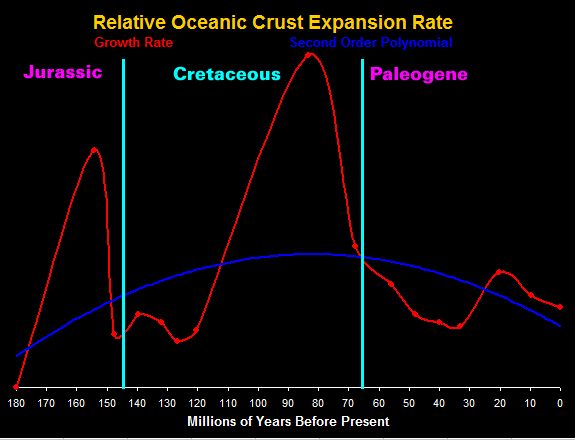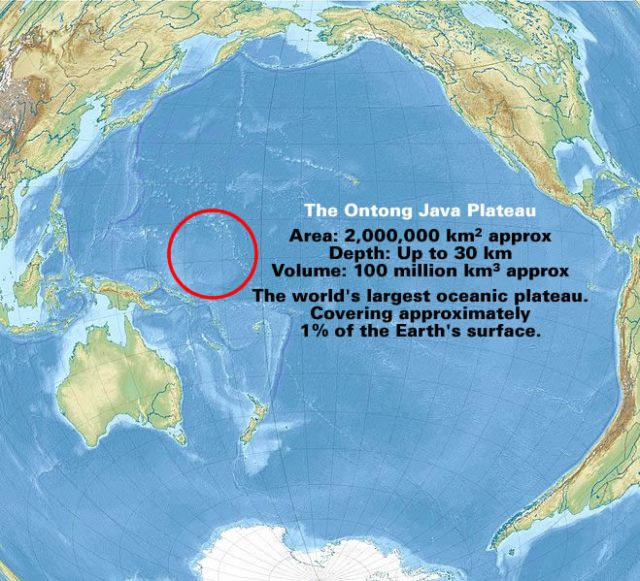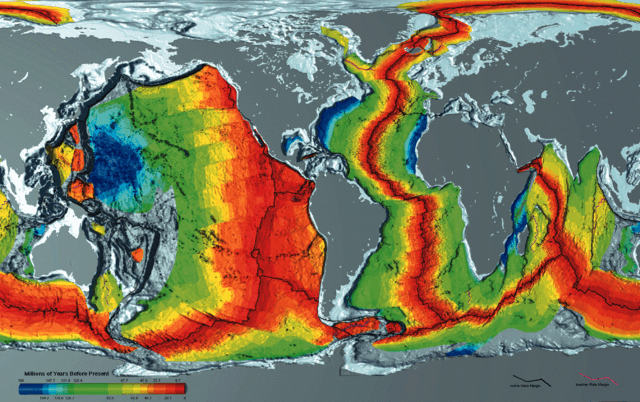The Society for Interdisciplinary Studies is curious to know why so much chalk was formed in the Cretaceous period.
This research impacts on the formation of chalk – thought to have been laid down in Cretaceous shallow seas over immense periods of time. Until now chalk is assumed, from the microscope, to have been formed from the broken and mangled skeletons of plankton and the algae that fed on them.
Why so much chalk was formed in the Cretaceous has never been explained properly…
Fish – builders of the chalk?
http://www.sis-group.org.uk/news/fish-builders-chalk.htm
The answer is very straight forward when the mainstream miasma and misdirection is cleared away.
The first step in this “mainstream tragedy” is a bit of scene setting.
The Cretaceous period was [roughly] between 145 and 66 million years ago according to the mainstream chronology and was immediately preceded by the Jurassic period.
The Cretaceous, derived from the Latin “creta” (chalk), usually abbreviated K for its German translation Kreide (chalk), is a geologic period and system from circa 145 ± 4 to 66 million years (Ma) ago.
The Cretaceous period was relatively warm with “high eustatic sea levels”, reptiles inhabited the seas and dinosaurs dominated the land.
The Cretaceous was a period with a relatively warm climate, resulting in high eustatic sea levels and creating numerous shallow inland seas. These oceans and seas were populated with now extinct marine reptiles, ammonites and rudists, while dinosaurs continued to dominate on land.
The Wikipedia introduction is fairly “laid back” about the Cretaceous period.
However, the Cretaceous period was a time of change.
Firstly, there was outgassing of oxygen [O2] because levels rose from 26% to 30% by volume.
Secondly, the level of atmospheric CO2 [Carbon Dioxide] fell from 1,950 ppm to 1,700 ppm.
Thirdly, the average surface temperatures rose by 1.5 degrees centigrade.
Jurassic [201 – 145 million years ago]
Mean atmospheric O2 content: ca. 26 vol % (130 % of modern level)
Mean atmospheric CO2 content: ca. 1950 ppm (7 times pre-industrial level)
Mean surface temperature: ca. 16.5 °C (3 °C above modern level)
http://en.wikipedia.org/wiki/JurassicCretaceous [145 – 66 million years ago according
Mean atmospheric O2 content: ca. 30 vol % (150 % of modern level)
Mean atmospheric CO2 content: ca. 1700 ppm (6 times pre-industrial level)
Mean surface temperature: ca. 18 °C (4 °C above modern level)
http://en.wikipedia.org/wiki/Cretaceous
http://en.wikipedia.org/wiki/Carbon_dioxide_in_Earth%27s_atmosphere
However, the most surprising element that is glossed over by Wikipedia is the observation that global sea level rose to “high” levels during the Cretaceous period.
This is the remarkable truth obscured by the Wikipedia phrase “high eustatic sea levels”.
Eustatic
Denoting or relating to worldwide changes in sea level, caused by the melting of ice sheets, movements of the ocean floor, sedimentation, etc.
Remarkable is really an understatement because:
1) The Jurassic wasn’t an “ice age” so a 1.5 C rise in the Cretaceous couldn’t melt much ice.
2) The Jurassic experienced the first “wave” of seafloor stretching that “broke up” the continents.
3) The Jurassic experienced a continually rising sea level.
4) The Cretaceous experienced the second “wave” of seafloor stretching.
It is also very remarkable that the level of atmospheric carbon dioxide fell during the Cretaceous because the largest of the Large Igneous Provinces of flood basalt formed during the Cretaceous.
The Ontong Java Plateau is a huge oceanic plateau located in the Pacific Ocean, lying north of the Solomon Islands. The plateau covers an area of approximately 2,000,000 km2 (770,000 sq mi), or roughly the size of Alaska, and reaches a thickness of up to 30 km (19 mi).
The plateau is of volcanic origin, composed mostly of flood basalts.
Although they are now separated by thousands of kilometres, Manihiki Plateau and Hikurangi Plateau were then part of the same large igneous province, forming the world’s largest oceanic plateau.
It extruded some 100 million km3 of magma, covering approximately 1% of the Earth’s surface, in one of the largest volcanic events on Earth in the last 300 million years.
The Ontong Java Plateau was formed 125–120 million years ago possibly by the initial plume-head phase of a mantle plume center called the Louisville hotspot.
The timing corresponds roughly to the early Aptian anoxic event in the oceans.
Most of the rocks that make up the plateaus have been dated to 125–119 million years ago, in the Lower Cretaceous Epoch, with some secondary volcanism occurring 20–40 million years later, in the Upper Cretaceous Epoch.
http://en.wikipedia.org/wiki/Ontong-Java_Plateau
http://en.wikipedia.org/wiki/Large_igneous_province
Clearly, the Cretaceous experienced the extrusion of huge quantities of volcanic basalt and huge quantities of volcanic gases such as water vapour, carbon dioxide and oxygen.
The principal components of volcanic gases are water vapor (H2O), carbon dioxide (CO2), sulfur either as sulfur dioxide (SO2) (high-temperature volcanic gases) or hydrogen sulfide (H2S) (low-temperature volcanic gases), nitrogen, argon, helium, neon, methane, carbon monoxide and hydrogen. Other compounds detected in volcanic gases are oxygen (meteoric), hydrogen chloride, hydrogen fluoride, hydrogen bromide, nitrogen oxide (NOx), sulfur hexafluoride, carbonyl sulfide, and organic compounds. Exotic trace compounds include methylmercury, halocarbons (including CFCs), and halogen oxide radicals.
The abundance of gases varies considerably from volcano to volcano. Water vapor is consistently the most common volcanic gas, normally comprising more than 60% of total emissions. Carbon dioxide typically accounts for 10 to 40% of emissions.
This outgassing directly attributable to the Ontong Java Plateau event was significant augmented by additional seafloor spreading in the Pacific, Atlantic and Indian oceans.
The Cretaceous seafloor spreading is marked in very light blue and green
The mainstream avoids drawing attention to the obvious massive levels of outgassing and bizarrely misdirects by claiming the volcanic oxygen is of “meteoric” origin.
This is similar to their delusional fixation regarding extraterrestrial water sources.
See: https://malagabay.wordpress.com/2013/02/26/running-hot-and-cold-extraterrestrial-water
See: https://malagabay.wordpress.com/2012/10/07/inventions-and-deceptions-extraterrestrial-water
However, there are occasions when the mainstream begins to “joint up the dots”.
Interestingly, the mainstream have observed that the timing of the Ontong Java Plateau event “corresponds roughly to the early Aptian anoxic event in the oceans” in the Cretaceous period.
Oceanic anoxic events or anoxic events occur when the Earth’s oceans become completely depleted of oxygen (O2) below the surface levels. Although anoxic events have not happened for millions of years, the geological record shows that they happened many times in the past. Anoxic events may have caused mass extinctions. These mass extinctions include some that geobiologists use as time markers in biostratigraphic dating.
…
It was the finding of black carbon-rich shales in Cretaceous sediments that had accumulated on submarine volcanic plateaus (Shatsky Rise, Manihiki Plateau), coupled with the fact that they were identical in age with similar deposits cored from the Atlantic Ocean and known from outcrops in Europe – particularly in the geological record of the otherwise limestone-dominated Apennines chain in Italy – that led to the realization that these widespread intervals of similar strata recorded highly unusual oxygen-depleted conditions in the world ocean during several distinct discrete periods of geological time.Sedimentological investigations of these organic-rich sediments, which have continued to this day, typically reveal the presence of fine laminations undisturbed by bottom-dwelling fauna, indicating anoxic conditions on the sea floor, believed to be coincident with a low lying poisonous layer of hydrogen sulfide.
Furthermore, detailed organic geochemical studies have recently revealed the presence of molecules (so-called biomarkers) that derive from both purple sulfur bacteria and green sulfur bacteria: organisms that required both light and free hydrogen sulfide (H2S), illustrating that anoxic conditions extended high into the illuminated upper water column.
The anoxic conditions [extending “high into the illuminated upper water column”] are a pivotal clue to our understanding of the chalky Cretaceous…. to be continued.







The Cretaceous period is also known in the diamond exploration business, (The De Beers version), as the global period of most ‘kimberlite’ eruptions. Kimberlite magmas erupt as fluidised – CO2 saturated plasmas.
Except that most occurred within Africa, and there was another burst of eruptions during the Alpide event (See SW Carey for ‘event’ labelling) but no reporting of CO2 deposits of scale to the Cretaceous period.
It’s also related to the dolomite problem (MgCaCO3) where vast quantities of magnesian dolomites were deposited on the Earth’s surface.
(I’ve ordered a digital version of the geology of the world from the French organisation responsible for its compilation and I am still waiting! 6 moths now).